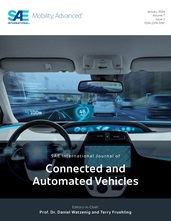Cross-Track-Compensated Pure Pursuit Control of an Autonomous Vehicle on Low-Friction Surfaces
- Content
- In order for autonomous vehicles to be successfully integrated into the transportation system, they must be able to handle the variety of environments and driving scenarios that a human driver is able to. One such scenario is the use of a double lane change for obstacle avoidance with an unexpected change of friction coefficient present with below-freezing temperatures. A low-friction surface that is not detected by the vehicle could result in a vehicle running off the road during this maneuver. This article presents a modification to the commonly used pure pursuit control method that stabilizes the vehicle during this maneuver by dynamically changing the look-ahead distance based on cross-track error and vehicle velocity. Hardware results on an autonomous vehicle platform show an elimination of off-road occurrences for double lane change and a 46% reduction of off-road occurrences for single lane changes. The overall stability of the autonomous vehicle is also improved, decreasing oscillations around the planned path during maneuver execution.
- Pages
- 12
- Citation
- Spike, N., Robinette, D., Bos, J., Chopp, D. et al., "Cross-Track-Compensated Pure Pursuit Control of an Autonomous Vehicle on Low-Friction Surfaces," SAE Int. J. CAV 4(2):177-188, 2021, https://doi.org/10.4271/12-04-02-0014.
